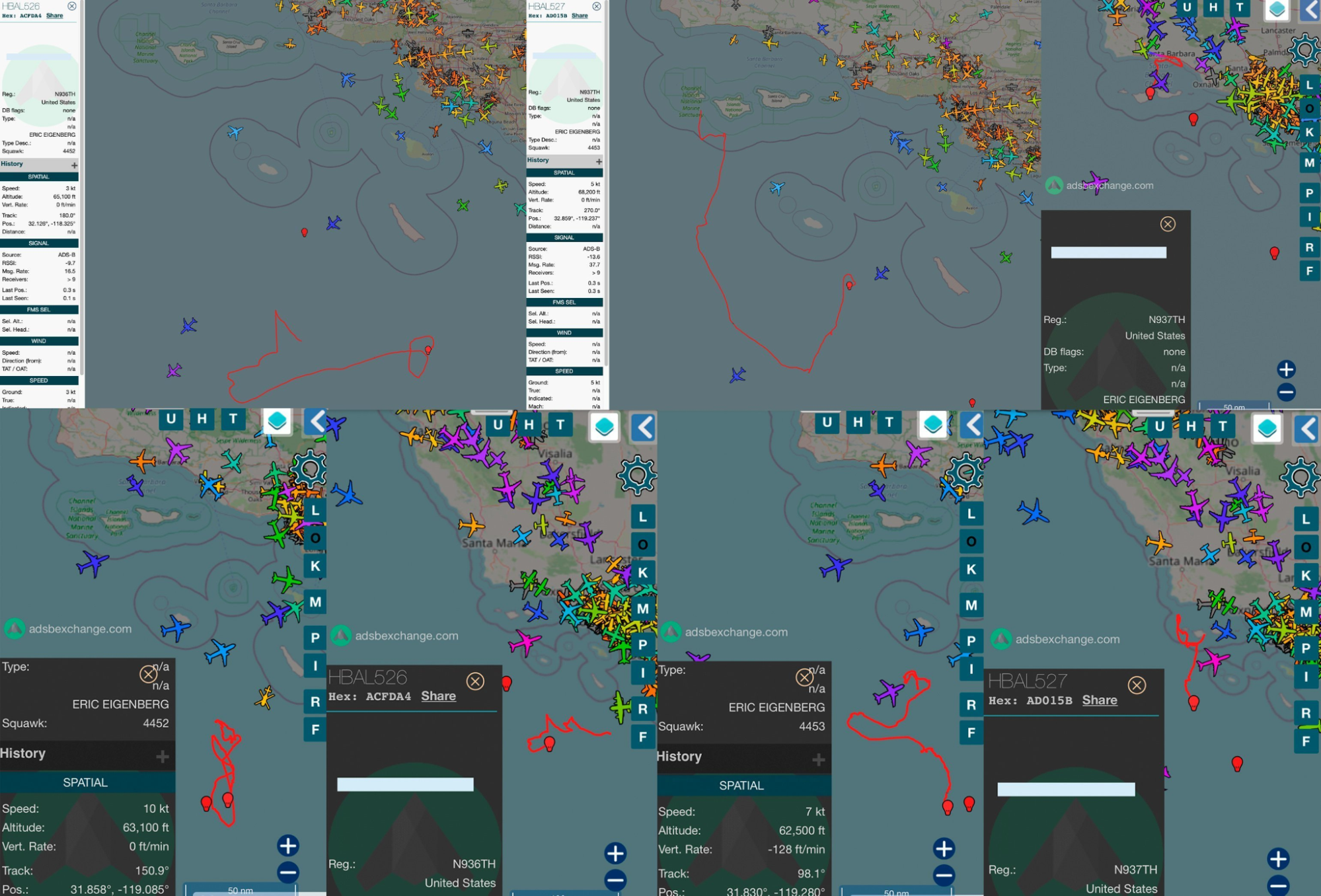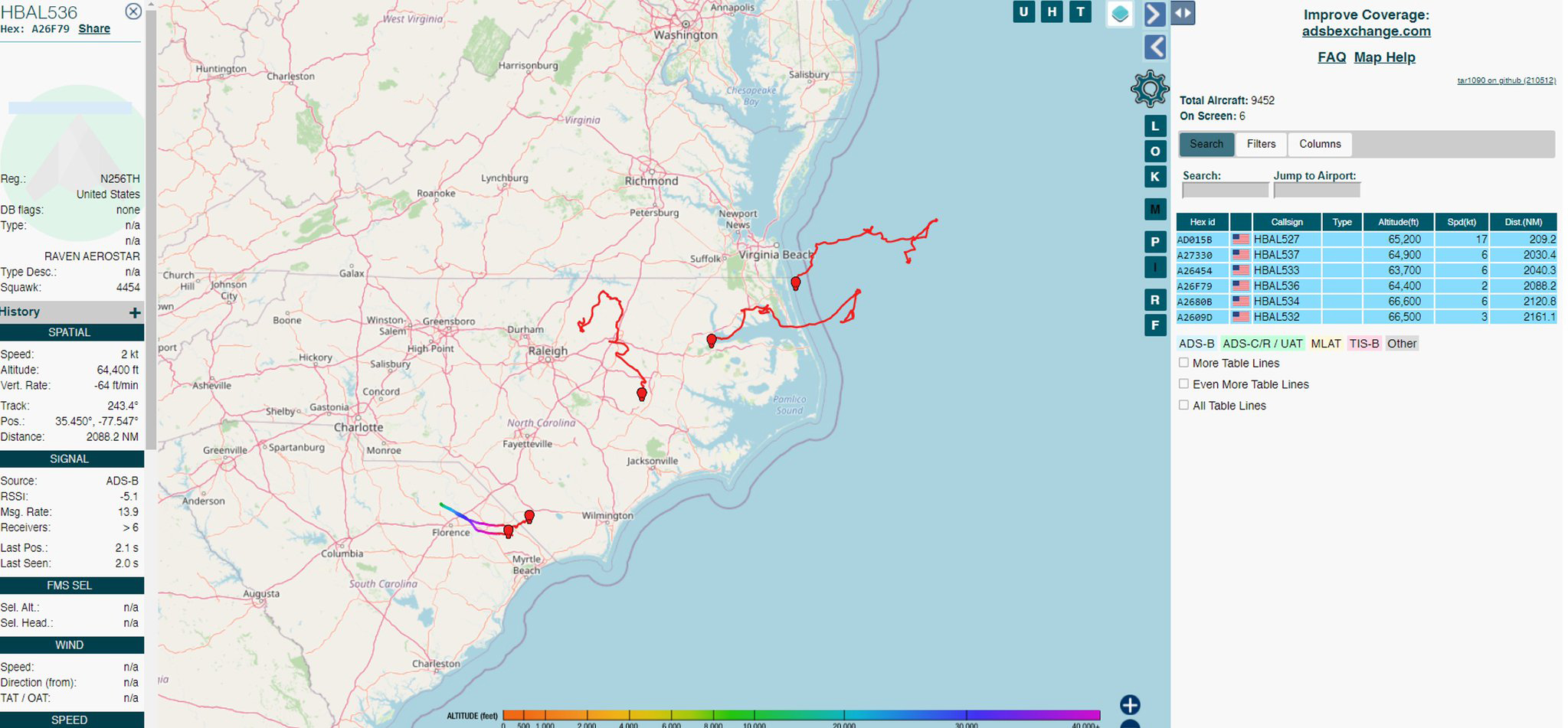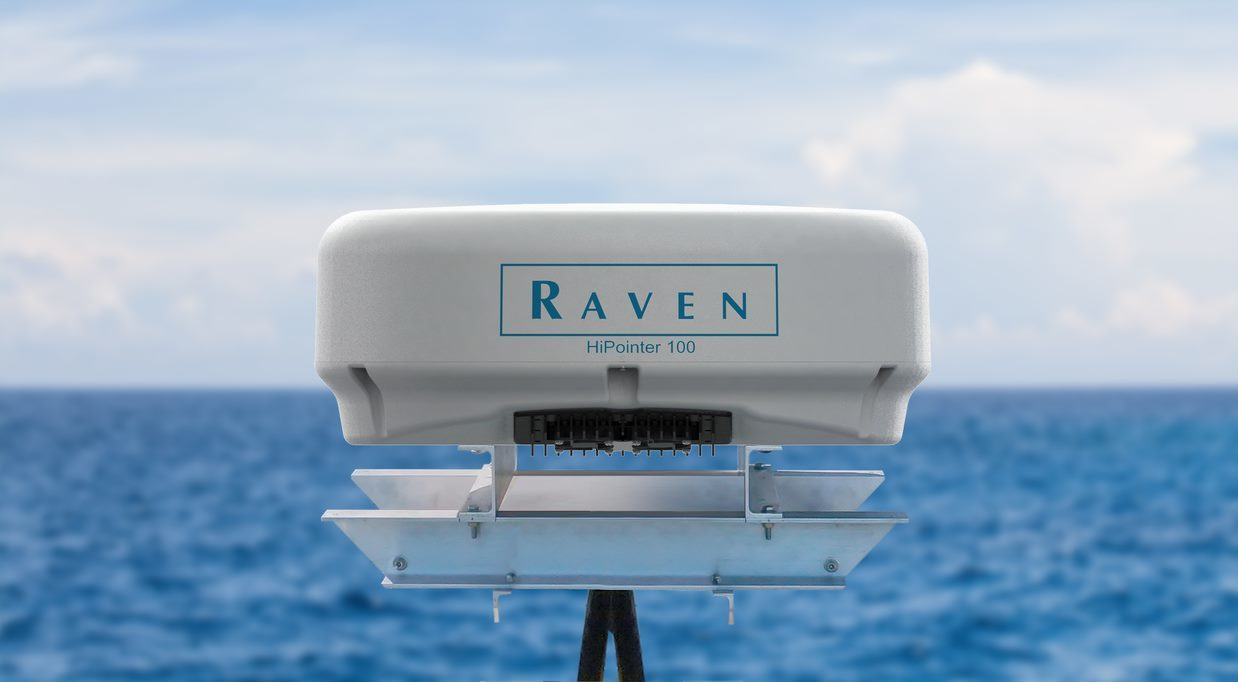Over the last week at least nine sophisticated balloons have been flying off both coasts of the United States, mainly in areas usually associated with military training and testing. The transponder-equipped balloons have caught the interest of those monitoring flight tracking software, and have even been spotted from down below in a few instances. Observers have noted their ability to hold station for long periods of time and to seemingly fly against prevailing winds. With all this in mind, we decided to investigate, here’s what we found out so far.
These high-altitude balloons are the property of Raven Aerostar, a division of Raven Industries, based in Sioux Falls, South Dakota. In recent years, Raven Aerostar has been known for its collaboration with Google’s parent company Alphabet in Project Loon, an ambitious venture intended to extend Internet access to rural areas. The “Loon balloons” were designed by Raven Aerostar to fly at high altitude for extremely long durations. Project Loon announced it would shut down in January this year, despite making significant technical strides. Since then, Raven Aerostar has continued to develop its balloon technologies for other sectors, notably in the realm of intelligence and defense.

The vehicles appear to be derivatives of Raven Aerostar’s Thunderhead balloon system. The Thunderhead balloons are designed to be able to persist over an area of interest in order to carry out a wide variety of tasks. According to the company, common applications include intelligence, surveillance, and reconnaissance (ISR) missions and acting as communications relays. Additionally, the balloons can also serve roles in augmenting navigational systems.
According to a recently published textbook titled “Stratospheric Balloons: Science and Commerce at the Edge of Space” by Manfred von Ehrenfried, the Thunderhead balloon system is steerable and can be flown individually or in constellations. The Thunderhead is a super-pressure balloon (SPB) with a gondola that contains a payload, flight system, and solar panels. The balloon itself is pumpkin-shaped and composed of polyethylene. The system has two configurations: the Thunderhead 200 SPB with a 64,000 cubic foot volume, or the 400 SPB with a 400,000 cubic foot volume. The 200 SPB has a maximum altitude of 50,000 to 60,000 feet, while the 400 SPB has a maximum altitude of up to 92,000 feet.

Within the main balloon, there is a smaller balloon referred to as a “ballonet.” The ballonet acts as a ballast, and functions as the central component of the steering system. Air is introduced into the ballonet using a pump, permitting the balloon to modify its weight to ascend or descend. Operators cannot directly control the course or speed, but the altitude changes, along with real-time weather awareness, allow the balloon to leverage wind patterns at different altitudes in order to navigate, including staying in a particular area for a long period of time. According to von Ehrenfried, flight times can exceed 30 days.

Raven Aerostar produced a brief video in July of 2020, seen below, explaining the Thunderhead’s capabilities, emphasizing its ability to linger at extremely high altitudes over contested airspace. The company underscored that by networking balloons together, they can provide months of persistent services over a very large area. In the military and intelligence sense, these can include advanced networking capabilities, as well as carrying advanced radar sensors, electronic intelligence gathering systems, electronic warfare packages, optical payloads, and much more. Due to their high altitude, they can remain out of reach of many traditional anti-air countermeasures.

Their recent appearance over both coasts of the United States appears to be a test of exactly this networking capability. Federal Communications Commissions records reflect an approved license for one of Raven Aerostar’s subsidiaries, Aerostar Technical Solutions, to fly balloons within a two hundred-mile radius around Vista, California from May 9th until May 30th this year.
The stated purpose is to test networked radio systems, the Silvus 4400E and Silvus 4200E, on the high altitude balloons. Although the application only lists the California locations, further correspondence in FCC records show a conversation about permitting additional locations on the East Coast:

The company appears to have aggressively pursued its balloon testing in recent years, with experimental radio license applications dating back until at least February 2020. Balloon tests had previously been approved and conducted across the Southeast and Southwest. For example, residents of Jackson, Mississippi may have noticed a meandering balloon track around May 4th this year.

During the same period of time, the company has been conducting tests of its new solid-state X-band radar technology platform, the HiPointer 100. Testing appears to be taking place near Norfolk, Virginia with an experimental license approved from April 5 until October 2, 2021. Unlike these roaming balloon tests, the HiPointer 100 testing appears to be constrained to within about three miles of a Norfolk naval facility.

The HiPointer 100 is designed primarily as a “perimeter defense and port security” tool according to Raven Aerostar. The device is highly portable and easy to use with minimal configuration. This includes the capability to be mounted on balloons, although it isn’t clear if it is being used in the ongoing balloon tests.
At least some of the balloon trials have been associated with defense technology contracts. FCC records reflect authorization for balloon flights around Stanley, New Mexico until December 1, 2021. Supplemental application materials divulge that the testing involves work under Defense Technical Information Contract FA8075-14-D-D0014. The contract identification appears to be a typo of FA8075-14-D-00014, a $1.8 billion dollar research contract held by Alion Science and Technology Corporation.
The broader contract includes projects like this one, focused on “unmanned aircraft systems for intelligence, surveillance, reconnaissance, targeting and precision strike capabilities for naval air systems command persistent maritime UAS program office.”
Raven Aerostar itself celebrated a five-year multiple-award contract from Naval Sea Command Systems (NAVSEA) in February of last year. The work cited involves the “Unmanned Vessel market” and their “Perception Radar solution,” according to the General Manager of Aerostar Technical Solutions, Michael Schwartz.
The company has a rich history of working in the defense and intelligence realm. In 2011, engineers associated with the current balloon program were presented with awards from the Naval Air Warfare Center for its work in supporting intelligence efforts in Afghanistan. Specifically, the award cited the company’s work on the Persistent Ground Surveillance System (PGSS), which is designed to monitor insurgent activity with high persistence balloons.
Raven Aerostar also notably carried out tests involving balloons carrying ISR systems at altitudes of around 65,000 feet over six states in 2019. U.S. Southern Command (SOUTHCOM) sponsored that work as part of an experiment to evaluate whether this could a useful additional tool for supporting counter-narcotics and disaster response operations, along with more general intelligence collection requirements.
Although often overlooked, balloons have seen a modern resurgence as a reconnaissance and communications platform in recent years, with intense interest from more than one service branch. The War Zone previously reported on the Army’s plans to leverage balloons that can deploy drone swarms from high altitudes and penetrate into contested airspace for extended periods of time while carrying radars, electronic warfare and electronic intelligence systems, networking relays, and other payloads as a key future operational concept.

The recent contracts with NAVSEA suggest that the Navy may be interested in some similar ideas. With that in mind, it’s also important to note that high altitude balloons with unspecified payloads were employed during a recent large-scale exercise focused on evaluating various unmanned capabilities and associated concepts of operations that the service held off the coast of southern California in April.
Though the Navy does not appear to have specified the type of balloons used during that exercise, which was called Unmanned Integrated Battle Problem 21 (UxS IBP 21), footage and imagery the service released showed individuals wearing hardhats with the Raven Aerostar logo on them launching a Thunderhead.

In addition, intriguingly, the balloons currently deployed have been launched from or are lingering in areas that have come to be known as drone incursion hotspots involving the Navy. The balloons off the coast of Southern California have largely operated in the vicinity of San Clemente Island. In 2019, a still-unidentified group of drones harassed Navy vessels around that area over the course of several days.

On the east coast, some of the balloons appear to have been lingering near a naval warning area where a number of aviation safety incidents involving unusual aircraft were reported over much of the last decade.

While FCC records do not specify any specific payloads beyond the radios being tested, it is notable that balloons often equipped for reconnaissance are being fielded precisely in two recent hotspots for drone incursion activity. It is unclear if that is coincidental, although it likely is as these are established training and testing ranges, or if the Raven Aerostar balloons could play a role in monitoring for unusual activity. Raven’s systems are especially capable of detecting and pointing out targets of interest and anomalous activity and have the persistence to stay overhead far longer than any normal fixed-wing aircraft can.
In the coming days, we’ll be keeping an eye out for Raven Aerostar’s balloons off the coasts of the United States, and the continued development of this intriguing but often overlooked intelligence and communications platform. We have reached out to Raven Aerostar to learn more about their fascinating platform, and about these ongoing tests.
Contact the author: adam@thewarzone.com
